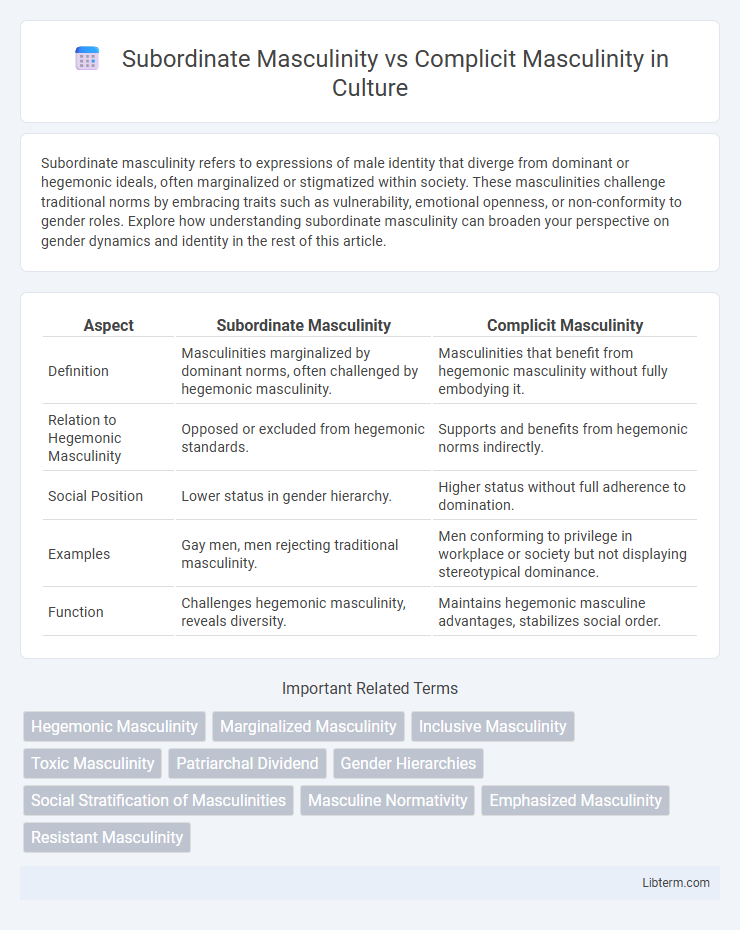Subordinate masculinity refers to expressions of male identity that diverge from dominant or hegemonic ideals, often marginalized or stigmatized within society. These masculinities challenge traditional norms by embracing traits such as vulnerability, emotional openness, or non-conformity to gender roles. Explore how understanding subordinate masculinity can broaden your perspective on gender dynamics and identity in the rest of this article.
Table of Comparison
| Aspect | Subordinate Masculinity | Complicit Masculinity |
|---|---|---|
| Definition | Masculinities marginalized by dominant norms, often challenged by hegemonic masculinity. | Masculinities that benefit from hegemonic masculinity without fully embodying it. |
| Relation to Hegemonic Masculinity | Opposed or excluded from hegemonic standards. | Supports and benefits from hegemonic norms indirectly. |
| Social Position | Lower status in gender hierarchy. | Higher status without full adherence to domination. |
| Examples | Gay men, men rejecting traditional masculinity. | Men conforming to privilege in workplace or society but not displaying stereotypical dominance. |
| Function | Challenges hegemonic masculinity, reveals diversity. | Maintains hegemonic masculine advantages, stabilizes social order. |
Understanding Masculinity: An Overview
Subordinate masculinity refers to masculinities that are marginalized or devalued within dominant gender hierarchies, often opposing hegemonic ideals through expressions that diverge from traditional norms. Complicit masculinity involves men who do not embody hegemonic masculinity but benefit from the prevailing patriarchal system by conforming to or supporting dominant gender roles. Understanding these concepts highlights the complex spectrum of male identities and the social structures that reinforce power dynamics within masculinity studies.
Defining Subordinate Masculinity
Subordinate masculinity refers to forms of masculinity that are marginalized and devalued because they do not conform to the dominant ideals of hegemonic masculinity, such as being non-violent, emotionally expressive, or associated with lower social status. It is characterized by traits or identities that challenge or fall outside the dominant norms, including gay masculinity or masculinities expressed by racial minorities. This concept highlights the hierarchical nature of masculinities, where subordinate masculinities are positioned in opposition or inferiority to the dominant, complicit masculinity that benefits from and upholds the hegemonic structure without directly challenging it.
What is Complicit Masculinity?
Complicit masculinity refers to a form of male identity that does not directly conform to traditional hegemonic masculinity but benefits from and supports its dominant status. Men enacting complicit masculinity accept and advance gender norms by enjoying privileges created by hegemonic masculinity without actively embodying its more aggressive or dominant traits. This concept highlights how certain masculinities maintain systemic gender inequalities through passive endorsement rather than overt dominance.
Key Differences Between Subordinate and Complicit Masculinity
Subordinate masculinity challenges hegemonic masculinity by expressing traits or behaviors considered less dominant, often marginalized within societal gender hierarchies. Complicit masculinity supports hegemonic masculinity by benefiting from male privilege without actively embodying traditional dominant masculine ideals. The key difference lies in subordinate masculinity's resistance or marginalization, whereas complicit masculinity maintains and reinforces existing power structures while enjoying associated advantages.
Historical Contexts of Masculinity Hierarchies
Subordinate masculinity historically refers to masculinities marginalized due to race, class, or sexuality, contrasted with complicit masculinity that supports dominant patriarchal norms without embodying full hegemonic power. In early 20th-century industrial societies, working-class men often occupied subordinate roles, while middle-class men aligned with complicit masculinity by benefiting from the patriarchal system without challenging hegemonic ideals directly. These hierarchies reveal how masculinity is structured relationally, with dominant groups maintaining power by positioning some masculinities as subordinate or complicit within broader social and historical contexts.
Social Impacts of Subordinate Masculinity
Subordinate masculinity, often associated with marginalized groups, challenges dominant gender norms and highlights social inequalities in power and privilege. This form of masculinity can lead to stigmatization, limited access to resources, and social exclusion, reinforcing systemic disparities. By contrast, complicit masculinity benefits from patriarchal advantages without overtly challenging hegemonic masculinity, often perpetuating social hierarchies indirectly.
Privileges Associated with Complicit Masculinity
Complicit masculinity benefits from societal privileges such as greater access to leadership roles, higher income, and social acceptance due to conformity with dominant patriarchal norms. Unlike subordinate masculinity, which is marginalized or stigmatized for not aligning with hegemonic ideals, complicit masculinity leverages these privileges without necessarily embodying overt dominance. This dynamic reinforces systemic power structures by rewarding masculinity that supports traditional gender hierarchies while maintaining distance from traits considered subordinate.
Cultural Representations of Masculinity Types
Subordinate masculinity is culturally represented as marginalized or less dominant forms of masculinity, often associated with traits that challenge traditional hegemonic norms such as emotional expressiveness or non-heteronormativity. Complicit masculinity, by contrast, aligns with hegemonic ideals yet benefits from the patriarchal system without fully embodying the dominant traits, often depicted in media as compliant but influential figures who maintain existing power structures. These cultural representations reveal the nuanced spectrum within masculinity, highlighting power dynamics and societal expectations in shaping male identity.
Intersectionality: Race, Class, and Masculinity
Subordinate masculinity often intersects with marginalized racial and class identities, reflecting societal power imbalances that limit access to hegemonic masculinity for men of color and lower socioeconomic status. Complicit masculinity involves men who benefit from patriarchy and racial privilege without embodying hegemonic ideals themselves, thereby reinforcing structures of dominance through racial and class-based advantages. Intersectionality reveals how race and class intricately shape diverse masculinities, highlighting the complex ways in which identity categories reinforce or challenge hegemonic norms.
Challenging Masculinity Norms: Towards Inclusivity
Subordinate masculinity challenges traditional hegemonic norms by embodying traits or identities marginalized within dominant masculine ideals, such as emotional expressiveness or LGBTQ+ identities, thereby expanding the spectrum of accepted male behaviors. Complicit masculinity maintains alignment with dominant masculinity while indirectly supporting gender inequities, allowing individuals to benefit from patriarchy without overtly displaying hegemonic traits. Advancing inclusivity requires disrupting these hierarchies through embracing diverse masculinities, promoting intersectional understanding, and fostering cultural shifts that validate alternative masculine expressions beyond dominance and control.
Subordinate Masculinity Infographic

 libterm.com
libterm.com